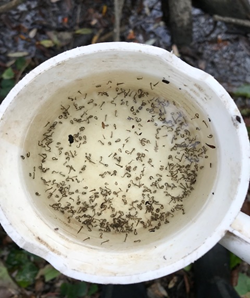2025 Mosquito Surveillance
Adult Mosquitoes (carbon-dioxide trap data)
n October, adult mosquito counts remained low except for Culex pipiens mosquitoes, which were captured in slightly higher-than-average numbers.
Culex pipiens is a mosquito adapted to living in residential and urban areas. It is a West Nile virus vector and the main target of the seasonal catch basin control program. The elevated numbers in October reflect a combination of late-season mosquito breeding sources including catch basins, broken pipes, miscellaneous containers and sewer plant maintenance issues.
Culex erythrothorax was trapped at substantially lower numbers than average this year. This mosquito species, which breeds in tules at the edges of lakes and ponds, has been suppressed over the last three summers by District control efforts but historically had very high abundances in the warmer months.
The following table and graph show the average number of mosquitoes collected per trap per night during October. The second graph on the next page shows the five-year average of mosquito counts over the different months of the year.
| Species | October 2025 | 5-year October average |
|---|---|---|
| _Culex pipiens_ | 8.3 | 7.4 |
| _Culiseta incidens_ | 0.5 | 0.6 |
| _Culex tarsalis_ | 0.1 | 0.2 |
| _Culex erythrothorax_ | 0.4 | 5.7 |
| _Aedes sierrensis_ | 0.0 | <0.1 |
| _Aedes washinoi_ | <0.1 | <0.1 |
This chart shows the 5-year average number of mosquitoes collected per trap night by month in 2025. Data are shown for the six most common species found in San Mateo County.
This chart shows the 5-year average number of mosquitoes collected per trap night by month for the previous 5 years. Data are shown for the six most common species found in San Mateo County.
Larval Mosquitoes (collections from water sources)

During October, larval samples are collected from sources of standing water such as marshes, impounds, backyard fountains, fishponds, water under buildings, storm drains, containers, creeks, and tree holes. District staff collected 103 larval samples in October. Technicians use a dipper to take a sample of water and visually inspect it for mosquito larvae. If larvae are present, the sample is taken back to the District laboratory for species identification.
The collected samples contained larvae of six different mosquito species. Larval samples in October were dominated by Culiseta incidens, present in 68 of the 103 samples (66%). This mosquito is present year-round in San Mateo County and is frequently collected from fishponds, containers holding water, and freshwater impounds. The high number of Cs. incidens sampled reflects the focused effort of District technicians to collect samples from residential sources. This data provides records of species found from individual water sources and is helpful in early detection of introduced species.
Number and percent of larval samples containing each mosquito species from water samples collected in October 2025. Larval samples commonly contain multiple species.
Other commonly collected species were Culex pipiens (36% of samples), and Culex stigmatosoma (22% of samples). Culex pipiens breeds in underground sources such as storm drains and backyard sources including containers holding water and small fountains or bird baths, whereas Cx. stigmatosoma breeds in similar sources but prefers high organic content in the water. Culex pipiens is an important vector of West Nile virus. Culex stigmatosoma does not often bite humans but can play a role in West Nile virus transmission among birds.
Page last reviewed: November 13, 2025
